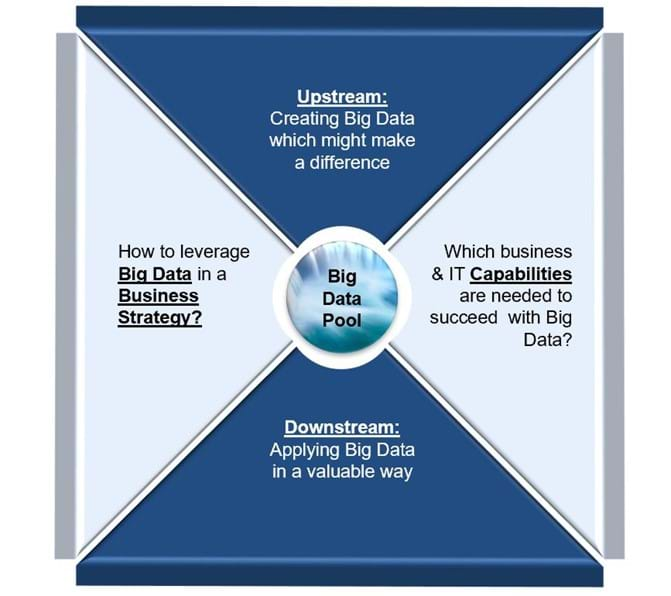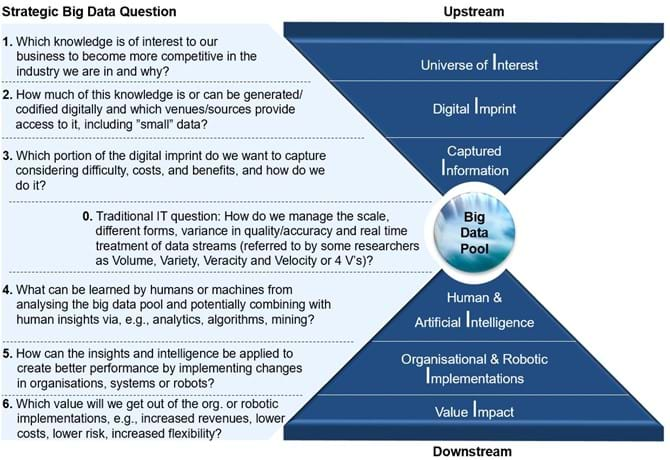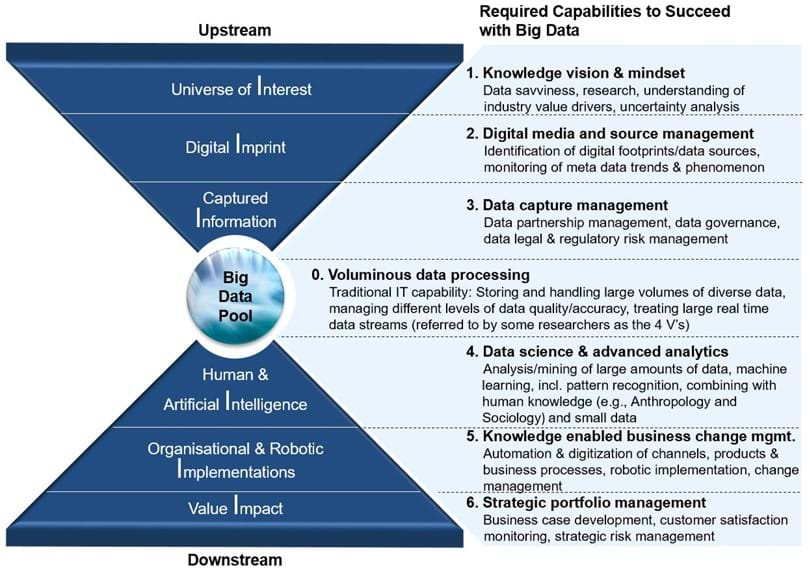The ever increasing digital data footprint and the exponential growth in computing power have created the so-called Big Data phenomenon. Many articles have been published on how to handle high volumes of diverse, constantly streaming data. But that is an IT issue. What about the formula for thinking through how to extract value from big data from a business perspective?
Based on Oleto Associates’ experience with Big Data, we believe companies should systematically consider 6 strategic questions, ranging from the interest they have in the data universe, to the value impact of a specific implementation.
“The Big Data discussion is too IT oriented. What about the formula for extracting value from a business perspective?”
- CEO of large service company
The Upstream and Downstream of Big Data
The Big Data value stream essentially consists of three parts, see exhibit 1.
The first part, the upstream part, covers the process of creating Big Data which might make a difference.



Exhibit 1: The Big Data value streams
The second part, the midstream, is where the Big Data Pool is stored and managed. It is this part that many IT researchers and analysts have debated in depth, trying to answer the question: How do we manage the scale, different forms, variance in quality/accuracy and real time treatment of large data streams? Also referred to by some as Volume, Variety, Veracity and Velosity or 4 V’s of Big Data.
The third part is the downstream which deals with applying Big Data in a valuable way for companies and organisations.
Around this value stream two key issues arise from a business perspective:
• How to leverage Big Data in a business strategy?
• Which business & IT capabilities are needed to succeed with Big Data?
The 6 Strategic “I” Questions for Big Data
By supplementing the traditional IT question with 6 business strategy questions, companies can get a great starting point for identifying how Big Data creates real value for them in their business strategies or even change these. The 6 questions evolve around the 6 key words: Interest, Imprint, Information, Intelligence, Implementation, and Impact, see exhibit 2.



Exhibit 2: The 6 strategic "I" questions for leveraging Big Data in a Business Strategy
More specifically the strategic "I" questions are:
1. Universe of Interest: Which knowledge is of interest to our business to become more competitive in the industry we are in and why?
2. Digital Imprint: How much of this knowledge is or can be generated/ codified digitally and which venues/sources provide access to it, including ”small” data from the company's own operation?
3. Captured Information: Which portion of the digital imprint do we want to capture considering difficulty, costs, and benefits, and how do we do it?
4. Human & Artificial Intelligence: What can be learned by humans or machines from analysing the big data pool and potentially combining with human insights via, e.g., analytics, algorithms, mining?
5. Organisational & Robotic Implementations: How can the insights and intelligence be applied to create better performance by implementing changes in organisations, systems or robots?
6. Value Impact: Which value will we get out of the organisational or robotic implementations, e.g., increased revenues, lower costs, lower risk, increased flexibility?
We have already proven this way of thinking in multiple industries and helped several organisations focus their Big Data efforts for greater value creation. Please see exhibit 3 for some simplified examples in retail banking, oil exploration, shipping, pulp & paper, pharma, and retail.


Exhibit 3: Applying the 6 strategic Big Data questions - Industry examples
For example, in the shipping industry, the Universe of Interest is ships movement, loads and weather patterns, since this knowledge enables the shipping companies to optimise asset utilisation and reduce cost. The Digital Footprint is the geo and operational ship specific data as well as ocean data, however the Captured Information most companies cover is limited to geo data and shipping data from multiple shipping companies. The Human & Artifical Intelligence to be derived from the Big Data Pool is correlations between sea movements, seaways and currents and shipping characteristics. The Organisational & Robotic Implementations will yield increased certainty in fuel predictions and usage, optimised shipping routes and monitoring to avoid failures due to harsh weather conditions. The resulting Value Impact of using Big Data this focused way is lower costs, lower operational risks, and higher asset utilisation which could enable more revenue.
The Required Business & IT Capabilities to Succeed With Big Data
The basic IT capabilities to be able to handle voluminous data processing are critical for companies to establish either in-house or outsourced, i.e., storing and handling large volumes of diverse data, managing different levels of data quality/accuracy, treating large real time data streams.
Equally important, companies need to establish six business capabilities to succeed with Big Data, covering both the upstream and downstream part of the Big Data value stream, see exhibit 4.


Exhibit 4: The business & IT capabilities required to succeed with Big Data
First of all, companies need a knowledge vision & mindset, i.e., a craving for wisdom to improve their businesses. That could mean data savviness, research, understanding of industry value drivers, and uncertainty analysis. Secondly, the ability to manage digital media and source management, identification of digital footprints/data sources, monitoring of meta data trends & phenonomens are crucial. Thirdly, companies need to master data capture management, data partnership management, data governance, data legal & regulatory risk management.
The fourth capability deals with data science & advanced analytics, analysis/mining of large amounts of data, machine learning, incl. pattern recognition, combining with human knowledge (e.g., Anthropology and Sociology) and small data. The fifth capability is the ability to execute knowledge enabled business change initiatives, e.g.., automation & digitization of channels, products & business processes, robotic implementation, change management. Lastly companies need strategic portfolio management since Big Data effort will be competing against other transformation initiatives in the company’s portfolio. This includes disciplines such as business case development, customer satisfaction monitoring, and strategic risk management.
The emphasis of each capability might vary, e.g., for industries which are already data intensive, it is a matter of exploiting what is already there (the downstream). For other industries capabilities need to be focused on both the upstream and downstream part of the Big Data value stream.
Where and How to Start?
Two overall approaches can be used to arrive at meaningful answers to the six strategic Big Data questions. Most companies would probably approach big data in a knowledge/bottom-up experimental driven way. These organisations would start with the upstream part and attack the questions in the order listed.
Other companies, in paticular the ones having a strong data foundation already, would start from the other end in a top-down value driven way. They would start with question number 6 in the downstream part and move their way backwards through the questions.
Both approaches can be very effective and many do a little of both.
We believe Big Data is only in its early days and in the years to come we will see numerous company and industry transformations enabled by the exciting opportunities Big Data can bring – when applied in a focused way and thoughtful way.
About the authors: This article was written by a team of consultants from Oleto Associates, a strategy consulting firm based in Denmark. For more information please visit www.oleto.com.
April 2016